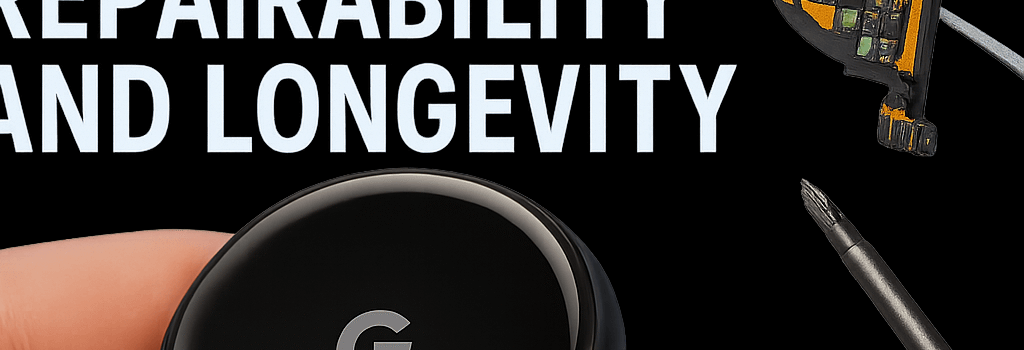Pixel Watch 4: Enhancing Repairability and Longevity

At Google’s annual Pixel event on August 20, the company is expected to unveil not only the Pixel 10 series but also the next generation of its smartwatch line—the Pixel Watch 4. For the first time, reports suggest that Google is rethinking its sealed, non-serviceable design in favor of a repairable, modular architecture that could drastically reduce e-waste and extend device lifespan.
Background: Google’s Wearable Design Philosophy
Since the launch of the original Pixel Watch in 2022, Google has maintained a unibody glass-and-aluminum construction. Each iteration—Watch, Watch 2, and Watch 3—has improved internal components, display brightness, and charging speed, but the core assembly remained the same: a curved Gorilla Glass cover fused to an aluminum housing with industrial adhesive.
“We wanted a seamless aesthetic that felt more like a high-end timepiece than a gadget,” a former Google hardware engineer told Ars Technica in 2023. “Unfortunately, that meant sacrificing serviceability.”
An E-Waste Challenge
The standard Gorilla Glass dome looks elegant but is susceptible to cracks and scratches. Unlike sapphire glass found on Apple Watch and some Samsung Galaxy Watches, Gorilla Glass rates a 7 on the Mohs hardness scale, making it more prone to damage under everyday wear.
- Global wearable tech disposal exceeds 50 million units annually.
- Non-repairable designs contribute up to 20% of consumer e-waste.
- Typical replacement costs for a damaged Pixel Watch: $199–$249 under Google’s protection plan.
Report: Toward a Modular, Repair-Friendly Pixel Watch 4
According to Android Headlines, the Pixel Watch 4 will feature a redesigned chassis allowing for component-level access. Key rumored changes include:
- Use of standard Torx screws and a gasketed backplate for battery and PCB removal.
- Modular display assembly detachable via clips rather than permanent adhesive.
- Interchangeable sensor modules for heart rate, SpO₂, and EDA measurements.
- Updated IP68 water-resistance sealing using O-rings instead of epoxy.
Technical Deep Dive: Modular Architecture & Component-Level Serviceability
The Pixel Watch 4’s new layout appears to follow the fracture fixed approach gaining traction in the repair community. Designers are reportedly:
- Routing flexible printed cables (FPC) through slots rather than bonding them under display glass.
- Adopting industry-standard ribbon connectors to simplify sensor swaps.
- Implementing a dual-layer EMI shield that doubles as a heat spreader, easily removable with a single screw.
Compliance with the upcoming EU Right to Repair directives and the US FTC final rule on appliance and wearable repairs may have pressured Google to open its hardware. These regulations will, by late 2025, require manufacturers to make schematics and spare parts available to independent shops.
Comparison with Competitors
Apple Watch Series 9 and Samsung Galaxy Watch 6 have long received praise for better repair scores. iFixit’s 2024 teardown rated the Apple Watch Series 8 at 6/10 and the Galaxy Watch 5 at 5/10 on repairability, compared to just 2/10 for the Pixel Watch 3. Most of that delta stems from:
- Sapphire crystal vs Gorilla Glass.
- Socketed components vs direct adhesive mounting.
- Official parts programs and refurbished units.
If Google implements similar design philosophies, the Pixel Watch 4 could close that gap and enable a robust third-party repair ecosystem.
Industry Impact & Sustainability Alignment
Google has pledged to operate on carbon-free energy by 2030 and achieve zero manufacturing waste by 2025. A repairable Pixel Watch aligns with these goals by:
- Reducing the number of units sent to recycling centers.
- Lowering raw-material extraction for new components.
- Extending device lifecycles, improving total-cost-of-ownership (TCO) for enterprise clients.
Counterpoint Research estimates a repairable smartwatch could cut e-waste by up to 15% in developed markets. Expert Michael Steiner, VP of Sustainability at iFixit, notes:
“Google’s move could catalyze an industry shift away from disposable wearables.”
Repair Options: Official vs Third-Party
Previously, Google offered a $4/month protection plan with a $49 service fee per incident, sending customers a brand-new unit instead of repaired or refurbished stock. With a repairable Pixel Watch 4, we expect:
- Official parts store for certified repair centers and Do-It-Yourself kits.
- Detailed service manuals published under permissive licenses.
- Potential partnerships with iFixit or uBreakiFix for authorized service.
Conclusion
If these reports prove accurate, the Pixel Watch 4 could mark Google’s most significant sustainability and customer-centric hardware pivot yet. By combining modular design with industry regulations, Google may finally deliver a smartwatch that’s not only stylish and powerful but also built to last—and to be fixed.